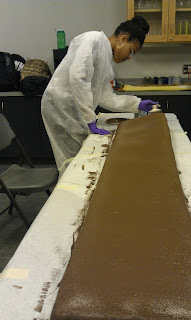It was an exciting end of the semester that culminated in the testing of our exhibits in the first week of December.
Expect our Tuesday and Thursday posts to start rolling in! The teens started back up on January 27th!!!
 |
| A young museum patron intrigued by the soil rug exhibit that the teens developed and built. |
 |
| Two of our teens displaying their project for the public. |
RECAP
Week 1: During week one the Interns and Educations introduced the program and our field of study to the teens. This was done by taking the teens through stations where they learned more about soil.
Week 2: During week two we read two stories from different Native American tribes about the creation of the earth. The teens split into two groups and each performed one of the 2 stories we read as a skit. This week the teens also researched different things about soil.
Week 3: During week three the Energy-Net team went to Schenley Park to learn about how to use a GPS. On Thursday, PhD candidate and paleoclimatologist David Pompeani gave a presentation about ancient lead pollution. He is responsible for finding the oldest lead pollution in the world!
Week 4: At Energy-NET this week the team gathered soil samples from Flagstaff Hill in Schenley Park On Thursday the teens broke out into groups and conducted a Town Hall Brownfield Debate!
Week 5: A presentation was giving from a Museum educator about evaluating an exhibit. After which the teens were sent to different parts of the museum to evaluate and look at how different exhibits worked.
Week 6: Week six was the idea and creation time. Teens broke into their different groups to develop and display their exhibits. These exhibit reigned from Pittsburgh Industrial History Timeline, to lead history. They also contained Soil Rug, create your own lot, and a video about why soil is important.
Week 7: It was crunch time! We deconstructed and evaluated our exhibits. After, the teens reconstructed the exhibits and presented them during the family day on Saturday.
*** To learn more about what we do and have done in the past, Please visit our past blog posts!!!!


























